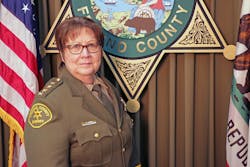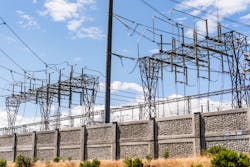After 9/11: Past, Present & Future
The September 11, 2021 terrorist attacks fundamentally changed how law enforcement views and responds to emergencies. It wasn’t just the 55,000 911 calls received after Flight 175 hit the South Tower, nor was it exposure of our problem of interoperability. From the perspective of those of us on the street in our black-and-whites, we recognized the shift in priorities, and needed to go from tail-wagging-dog to a proactive response...overnight.
In their study on post-9/11 policing, subject matter experts recognized the work that had to be done, and the emerging model that has shaped the future of policing.
There was an uptick in hate crimes, against groups who had nothing to do with the September 11 attacks, specifically Sikhs. In my region, we have several concentrated areas of Sikh populations, and our dispatch, at one time, was inundated with ignorant, “I just saw a terrorist” calls. This phenomenon added to another law enforcement tasks, and a shift in priorities. Law enforcement needed a way to put out accurate public education announcements efficiently.
Following 9/11, President Bush called for tolerance toward Muslims. In a PEW Research study released December 6, 2001, the favorable view of Muslims increased by November 2001.
Sheriff Margret Mims
I had the pleasure of interviewing Sheriff Margaret A. Mims, the Sheriff of Fresno County, California. She has been a peace officer since 1980, and was elected to Sheriff in 2006. Sheriff Mims is known for her common-sense approach to law enforcement, and is a law enforcement officer well-known and well-respected in the region.
Mims told me she was a lieutenant when we were attacked, and the Mutual Aid Coordinator for the agency. Moments following the attack, she received a phone call from a fellow lieutenant, telling her to turn on the television.
“I knew it was going to be big. I got the Situation Room up and running, and called State OES.” Mims further explained that this was one of the first times that they had used mass email addresses as a communication.
I’m certain that many remember that, for a brief period, all planes were grounded. For several days there were airport closures in their jurisdictions. As Mims told me this, I was thinking of what a huge task this would be in any region like Fresno County, which is in the Central Valley. There are commercial airports, like Fresno-Yosemite International Airport, smaller airports like Sierra Ski Park Airport, which serves smaller aircraft and smaller ventures, and then dozens, and I mean dozens, of airfields which serve agricultural fields throughout the area.
At the time, bomb sniffing canines weren’t really in prevalent use. In order to protect the public, they needed one.
I asked Mims what were some lessons learned from September 11. She told me that agencies learned to move quicker to share information. If someone has some information that might possibly be useful to another agency, it’s “Zoom now.” Sheriff Mims told me that since September 11, the communication amongst agencies has greatly improved.
She specifically talked about communication from federal agencies to local agencies, and said that as “local law enforcement agencies, we’re the ones coming in contact with the problems.” The concept of (If you) “see something, say something” was at the forefront.
What did that mean? We were on the alert for lone wolf cells, and encouraged everyone not to dismiss anomalies.
I asked Sheriff Mims what training and policy changes took place in the years after 9/11. Besides an uptick on information sharing, there were many significant changes in critical infrastructure. Like most agencies across the country, the Fresno Sheriff’s Department had to create a plan for incidents for which there really wasn’t a template.
Mims says, “We had to think outside the box. A terrorist attack can occur on a large farming operation, like a campaign to discredit our food supply. This could be done with a salmonella outbreak, which in terms of the farming operations in the region, could be an attack on the economy.
She continued with explaining that they have monthly meetings that include state and federal input. The federal agencies with which they work emphasize their link with local agencies.
“Oklahoma bomber Timothy McVeigh was apprehended on a vehicle stop,” says Mims, stressing the importance of local law enforcement. “We will never forget,” she added, “Our enemies want us to fail. They want to kill us.”
Indeed, they do, and I appreciate her leadership and emphasis on vigilance.What changed quickly
Law enforcement organization and structure has always had a rigid template. For example, the Time in Grade concept, where it is an agency’s policy to require an officer to be in a particular position for a designated period of time before they can promote, is a mainstay in organizational structure. Because policing has rigid structures, SOPs and established or embedded processes have maintained the stability and predictability of the organization.
After September 11, we began to view predictability as a problem. It wasn’t just law enforcement that recognized this either. Fire and EMS had the same problem. We realized that our template was so pervasive, that any amateur knew, “If this problem happens, the agency will deploy the following assets,” right down to, “If the call is here, expect to have a patrol car here, and a Critical Incident Team here.” After all, if they knew how to predict us, they knew how to overwhelm us.
This particular conversation had taken place over time already. For example, while I was an Infantry Company Executive Officer in the L.A. Riots, we had to strategize our deployment to cover routine responses in the city. This was a military briefing that took place in front of a Los Angeles City Fire crew that came under sniper fire, which put a few holes in the engine (note: this was April 30, 1992).
Adding a constant threat to those who respond to emergencies increases the number of resources, if they need to have a bolstered response. Planning for a response for terrorist attacks always has to include anticipating completely overwhelmed resources, pre-planned mutual aid templates, and interconnectivity.
I have played all three roles: civil military affairs, firefighting and policing. After 9/11, one way we responded was to train NIMS/SEMS (National Incident Management System, Standardized Emergency Management System) in basic courses, ensuring that it is understood at the entry level, not just at the supervisor level. The emphasis was to equip those “on the ground” to be cognizant of the “bigger picture” and how their role integrates there.
Law enforcement agencies needed an opportunity to conduct their operations without “tipping off” anyone that a terrorist investigation was taking place, in appropriate circumstances. The USA PATRIOT Act included a provision for this, which was called Delayed-Notice Search Warrants. In some cases, it proved to be valuable in unlocking terrorist activity.
In 1994, there was a DOD and DOJ agreement to transfer military surplus equipment to state, local, and federal law enforcement agencies. The purpose of this agreement was to bolster the War on Drugs. Similar bills also increased the cooperation between military and local authorities.
The general public’s sentiment about policing was very positive and supportive. Allowing local agencies to continue to equip using surplus property was an excellent means for gearing up against terror. After September 11, the public generally made the connection between the War on Drugs and the War on Terror, supporting necessary tools for successful Law Enforcement response.
What changed over time
It only took a few years before “Police Militarization” and “Sneak and Peek” (what “delayed-notice warrants” were called by the media) articles began appearing on a regular basis. Although police agencies across the country were serving their communities in the same way, the mainstream media was sparking a fire against the police.
The law enforcement profession doubled down with more community relations efforts than ever. The media responded by attacking the working cop, ignoring the steady increase of diversity and diversity training in the ranks. Our enemies are quite patient. Perhaps the vilification of policing in America in the media is another wave of the same attack. In this case, it would be a good idea to “follow the money.” There were other fuels to the fire, including the recent political move of trying to make the police the mask wearing enforcers.
Like Sheriff Mims said, we must think outside the box. In April 2013, unknown suspects shot rounds into a Pacific Gas and Electric Company transmission substation San Jose, California. This attack was known as the Metcalf Sniper Attack. Little is known about the suspects, but they knew where to shoot in order to disable the transformers. The power was quickly re-routed, as PG&E has been practicing redundancy for years. For the customer, few were alerted to the attack, except maybe a blink in their lights from power re-routing.
Afterward, 7.62 x 39 cases were found nearby, but there wasn’t much evidence. It was later concluded to be an “inside job.” For those who do think outside the box, it could be recognized as a probe.
What if the mission of the team that shot these transformers was to find out how fast power would be restored and the relative efficiency of the supply chain? Each of these substations has unique components. For example, the insulator parts, either porcelain or composite, are made in only a handful of places in the world. They are essentially custom products. What if the terrorists were tasked with tracing the time for resupply and refitting?What is in the future
There is absolutely no question that technology plays a role in our quest for safety. For example, we are finding out how the use of data swarming can increase public safety.
In 2019, the research team at the Berkeley Seismological Laboratory released an app called “My Shake.” This app monitors the movement of cell phones, and is alerted when many phones in an area are triggered at the same time. The algorithm was designed to recognize shake patterns, and distinguish everyday patterns from earthquakes. A regional measurement can gather data, and may someday be used to predict earthquakes. It’s still experimental now, but the future is on the horizon.
Using the same type of data swarming, input devices can be used to locate incidents. For example, if a large gathering like a concert has a wave of input devices migrating toward (or away from) a particular area, it may help identifying a disturbance before it gets out of hand. This same concept is driving the cooperation between doorbell and surveillance cameras and police agencies. It could connect modus operandi and regional crime incidents. It could also help identify a large-scale drug or terrorist organization.
We are also looking at a bolstered enemy, who received thousands of assets, and new recruits, as the United States abandons missions in Afghanistan. It was thought years ago that terrorist organizations would simply “wait out” the politics in the U.S. to reclaim assets. This is happening now. How this will play out on our own soil is hard to say.
About the Author

Officer Lindsey Bertomen (ret.), Contributing Editor
Lindsey Bertomen is a retired police officer and retired military small arms trainer. He teaches criminal justice at Hartnell College in Salinas, California, where serves as a POST administrator and firearms instructor. He also teaches civilian firearms classes, enjoys fly fishing, martial arts, and mountain biking. His articles have appeared in print and online for over two decades.


